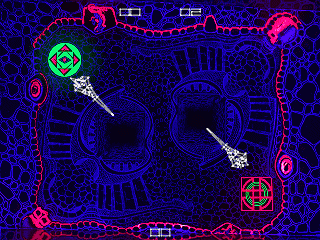 The Game: Two armored knights coalesce out of thin air in an enclosed arena, swords at the ready. Before they can do battle, there’s the matter of simply navigating the arena’s geography: a pair of bottomless pits can lead either knight to his death, and each pit is surrounded on two sides by a staircase than can make for a handy resting place – or an even deadlier place to duel. There’s also a narrow catwalk between the pits. If the knights can stay on firm ground, the sword-swinging begins; when a knight is vanquished, he re-forms in the corner where he first appeared and can charge into battle again until he has lost all of his lives. Whoever’s still standing at the end of the game wins. (Cinematronics/Vectorbeam, 1979)
The Game: Two armored knights coalesce out of thin air in an enclosed arena, swords at the ready. Before they can do battle, there’s the matter of simply navigating the arena’s geography: a pair of bottomless pits can lead either knight to his death, and each pit is surrounded on two sides by a staircase than can make for a handy resting place – or an even deadlier place to duel. There’s also a narrow catwalk between the pits. If the knights can stay on firm ground, the sword-swinging begins; when a knight is vanquished, he re-forms in the corner where he first appeared and can charge into battle again until he has lost all of his lives. Whoever’s still standing at the end of the game wins. (Cinematronics/Vectorbeam, 1979)
Memories: A great example of how new everything was in the early days of video games, Warrior is the first head-to-head fighting game, allowing two players to bash each other to bits (or stumble into the pits); there was no single-player mode. Graphically, the game is incredibly simple: the black & white vector graphics are responsible for nothing but the knights (nicely drawn and animated for the late 70s) and their respective scores. Everything else is a fluorescent-lit overhead view of the arena. That artwork could be seen through a half-silvered mirror, while the monitor itself actually displayed the graphics backwards so the mirror would show the knights over the playing field. This was a common trick of the day to achieve graphics that there simply wasn’t enough computer power to draw, but it was incredibly effective – and, at the time, it was all so new.
Warrior is also one of the very first games designed and programmed by Tim Skelly, a young programmer who was dropped into the deep end after Cinematronics’ chief game designer – and the inventor of their vector graphics hardware – bailed out of the company, taking all documentation about that hardware with him. (For more on that story, see Phosphor Dot Fossils’ history of Space Wars.) Given that it was a massive feat to decipher the now-undocumented development system that Cinematronics was left with, Skelly’s accomplishment in creating Warrior can’t be overstated. Ironically, Cinematronics wound up buying the company its former designer started after bolting, so Skelly’s game came out under that banner – “by Vectorbeam, a Cinematronics company.”
It’s also hard to ignore Warrior‘s place as one of the very first, if not the very first, arcade game to tap into the swords & sorcery mllieu of another 70s gaming mainstay, Dungeons & Dragons. Some university students had been crafting mainframe adventure games for years by this point, but for the general public, this was one of the first times that a computer set foot into the middle ages and took players with it, all for a quarter. And It Was Good.
It takes a little while to get into the swing of the controls – literally – as the same joystick controls governed the movement of both your knight and his sword (pressing a button would switch from one control scheme to the other; knights had to stand still to swash their respective buckles). But Warrior was one of a kind in its day. Two players had gone  head to head as Pong paddles before, or as tanks, but this time they were both people, locked in a grim duel. Take that same idea from an overhead perspective to a ground-level side perspective, and you have the forerunner of Mortal Kombat, Street Fighter and every head-to-head fighting to come down the pike since.
head to head as Pong paddles before, or as tanks, but this time they were both people, locked in a grim duel. Take that same idea from an overhead perspective to a ground-level side perspective, and you have the forerunner of Mortal Kombat, Street Fighter and every head-to-head fighting to come down the pike since.